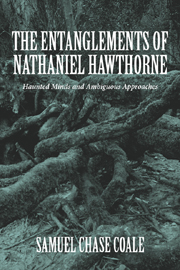Book contents
- Frontmatter
- Contents
- Acknowledgments
- List of Abbreviations
- Introduction: Entanglements
- 1 The Legacy of The Scarlet Letter: Hawthorne in Contemporary Culture
- 2 Hawthorne as Nineteenth-Century Morbid Genius
- 3 Biographical and Critical Veils in the Nineteenth Century
- 4 Biographical Visions of the Twentieth Century
- 5 Entangled Polarities: The New Criticism
- 6 Doubting Dualisms: The Strategies of Hawthorne's Romance
- 7 Ideological Contexts: Deconstruction, Feminism, the New Historicism, Race, and Entanglement
- Works Cited
- Index
4 - Biographical Visions of the Twentieth Century
Published online by Cambridge University Press: 12 September 2012
- Frontmatter
- Contents
- Acknowledgments
- List of Abbreviations
- Introduction: Entanglements
- 1 The Legacy of The Scarlet Letter: Hawthorne in Contemporary Culture
- 2 Hawthorne as Nineteenth-Century Morbid Genius
- 3 Biographical and Critical Veils in the Nineteenth Century
- 4 Biographical Visions of the Twentieth Century
- 5 Entangled Polarities: The New Criticism
- 6 Doubting Dualisms: The Strategies of Hawthorne's Romance
- 7 Ideological Contexts: Deconstruction, Feminism, the New Historicism, Race, and Entanglement
- Works Cited
- Index
Summary
At the turn of the twentieth century, psychology as the new science, based almost solely on Freud's descriptions of the Oedipal complex, social repression, and the unending battle between eros (love/sex) and thanatos (death), permeated the popular American consciousness so that “repression” became the buzzword of the 1920s. The impressionistic, genteel biographies and critiques of Hawthorne by his heirs, Julian (1884) and Rose (1897), and by such writers as Moncure D. Conway (1890), George E. Woodberry (1902), Frank Preston Stearns (1906), and Carl Van Doren (1921), gave way to the more deeply psychological portraits of a solitary and tormented Hawthorne as conjured up by Paul Elmore More in “The Solitude of Nathaniel Hawthorne” in the Atlantic Monthly of November 1901, and especially Newton Arvin's Hawthorne in 1929. This view of Hawthorne is still with us in the later critical biographies by Frederick Crews (1966), Gloria C. Erlich (1984), and Edward Haviland Miller (1991), culminating in T. Walter Herbert's presentation of the Hawthornes' middle-class marriage as a psychological battle of wills (1993).
Despite the several attempts to humanize Hawthorne and present him as both a genteel and pragmatic soul, the vision of solitude and strangeness did not so easily disappear. It lay at the heart of the notion of the solitary artist, the New England proto-Puritan with his basic Yankee reticence and diffidence. Even though More did “not wonder that his family, in their printed memoirs, should have endeavored in every way to set forth the social and sunny side of his character and should have published the Note-Books with the avowed purpose of dispelling the often expressed opinion that Mr. Hawthorne was gloomy and morbid … The predominant trait of Hawthorne’s work [remains] the penalty of solitude laid upon the human soul … and by right found its deepest expression in the New England heart.” The Hawthorne image, however questioned and interrogated, remained intact, underscored yet again by his regional background.
- Type
- Chapter
- Information
- The Entanglements of Nathaniel HawthorneHaunted Minds and Ambiguous Approaches, pp. 66 - 90Publisher: Boydell & BrewerPrint publication year: 2011

